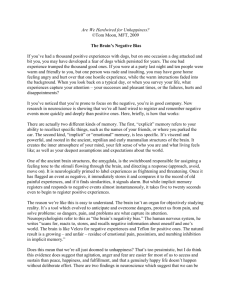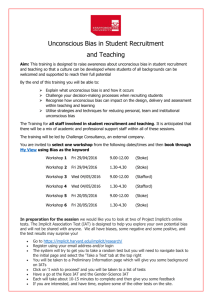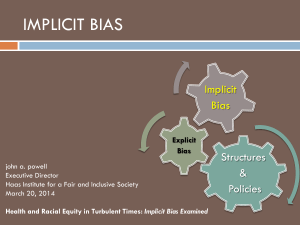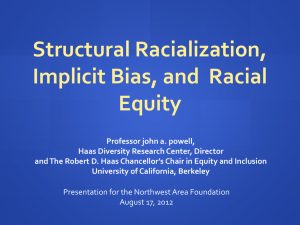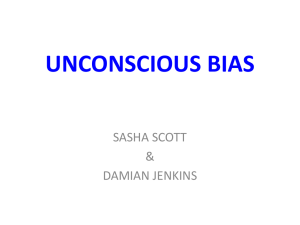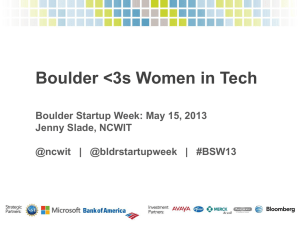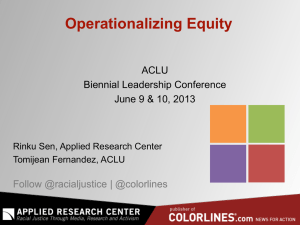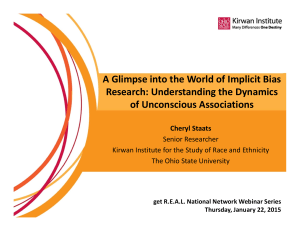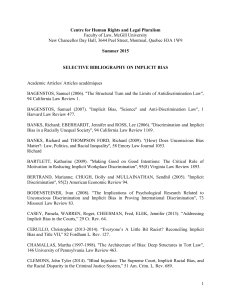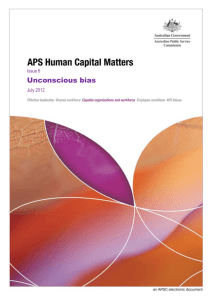The name problem is really hard
advertisement
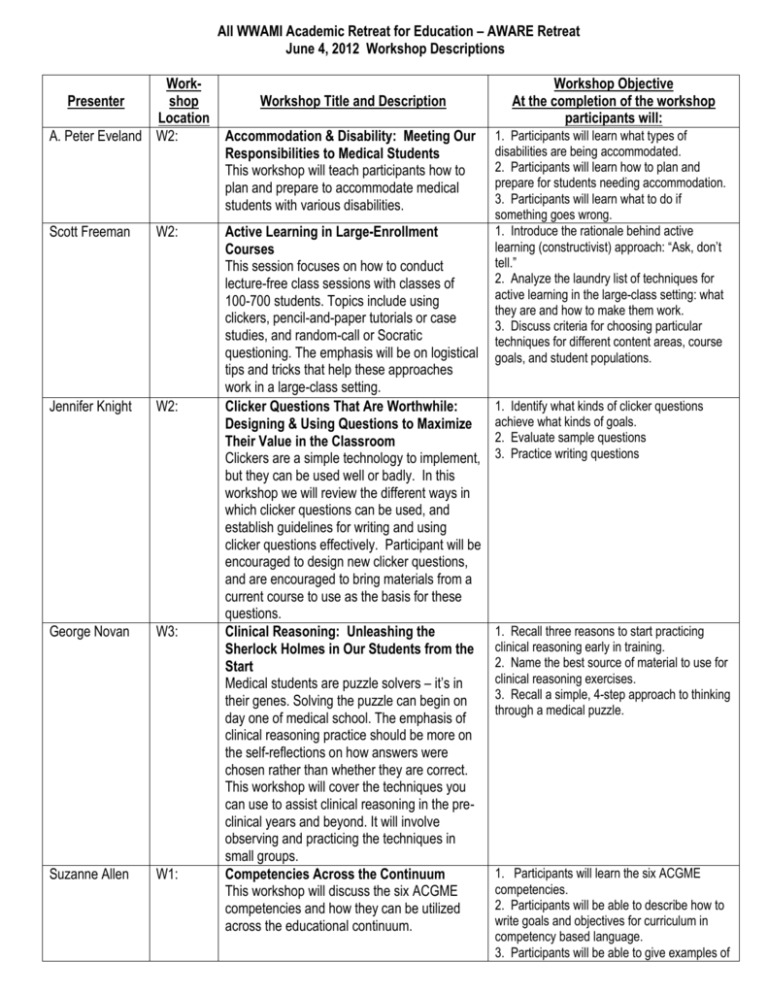
All WWAMI Academic Retreat for Education – AWARE Retreat June 4, 2012 Workshop Descriptions WorkPresenter shop Location A. Peter Eveland W2: Scott Freeman W2: Jennifer Knight W2: George Novan W3: Suzanne Allen W1: Workshop Title and Description Accommodation & Disability: Meeting Our Responsibilities to Medical Students This workshop will teach participants how to plan and prepare to accommodate medical students with various disabilities. Active Learning in Large-Enrollment Courses This session focuses on how to conduct lecture-free class sessions with classes of 100-700 students. Topics include using clickers, pencil-and-paper tutorials or case studies, and random-call or Socratic questioning. The emphasis will be on logistical tips and tricks that help these approaches work in a large-class setting. Clicker Questions That Are Worthwhile: Designing & Using Questions to Maximize Their Value in the Classroom Clickers are a simple technology to implement, but they can be used well or badly. In this workshop we will review the different ways in which clicker questions can be used, and establish guidelines for writing and using clicker questions effectively. Participant will be encouraged to design new clicker questions, and are encouraged to bring materials from a current course to use as the basis for these questions. Clinical Reasoning: Unleashing the Sherlock Holmes in Our Students from the Start Medical students are puzzle solvers – it’s in their genes. Solving the puzzle can begin on day one of medical school. The emphasis of clinical reasoning practice should be more on the self-reflections on how answers were chosen rather than whether they are correct. This workshop will cover the techniques you can use to assist clinical reasoning in the preclinical years and beyond. It will involve observing and practicing the techniques in small groups. Competencies Across the Continuum This workshop will discuss the six ACGME competencies and how they can be utilized across the educational continuum. Workshop Objective At the completion of the workshop participants will: 1. Participants will learn what types of disabilities are being accommodated. 2. Participants will learn how to plan and prepare for students needing accommodation. 3. Participants will learn what to do if something goes wrong. 1. Introduce the rationale behind active learning (constructivist) approach: “Ask, don’t tell.” 2. Analyze the laundry list of techniques for active learning in the large-class setting: what they are and how to make them work. 3. Discuss criteria for choosing particular techniques for different content areas, course goals, and student populations. 1. Identify what kinds of clicker questions achieve what kinds of goals. 2. Evaluate sample questions 3. Practice writing questions 1. Recall three reasons to start practicing clinical reasoning early in training. 2. Name the best source of material to use for clinical reasoning exercises. 3. Recall a simple, 4-step approach to thinking through a medical puzzle. 1. Participants will learn the six ACGME competencies. 2. Participants will be able to describe how to write goals and objectives for curriculum in competency based language. 3. Participants will be able to give examples of Doug Schaad W1: A. Peter Eveland W3: Craig Scott Abe DeSantis W3: David Acosta W1: Mark Wicks Doug Schaad W2: W3: CQI in the Educational Enterprise: Data Sources, Process and Implementation The intent of this workshop is provide participants with a comprehensive view of the methodologies used by the UWSoM in continuous quality improvement. Data will be presented for each aspect of the educational enterprise from first year through initial postgraduate experiences. FERPA 101: What You Need to Know This workshop will teach participants about the Federal Education Rights and Privacy Act (FERPA) and its application to access, transmission, and housing of student academic records. Generalizable Principles of Team-based Learning This workshop will be an exploration of the principles of team-based learning (TBL) in medical education and of how some of these principles can be incorporated into other approaches for promoting more active learning in medical education. The Impact of Images Used in Lectures: From Stereotype to Inclusion As students, we probably can all recount a time when we were in class and found ourselves staring at an image in disbelief used in a lecture by our faculty that provoked uneasiness, embarrassment, vulnerability, discomfort – even anger. What was the teacher’s intent for showing such an image? In academic medicine where humanism, professionalism, and respect for human life and dignity are taught, one would presume that this would have no place in the classroom. Yet, medical students complain year after year that some faculty continue to use images that promote stereotypes of certain racial/ethnic and gender identity groups. Participants in this session will examine case examples, rediscover and appreciate the significant impact that stereotypical images can have on learners, and then discuss how to develop lecture presentations with a cultural consciousness, and ultimately bring more inclusiveness to the images used in their classes. Medical Student Career Advising What kind of physician do I want to be? This question precedes admission to medical competencies across the undergraduate, graduate and continuing medical education continuum. 1. Know the elements of Continuous Quality Improvement processes within the UWSoM Curriculum. 2. Retain Point of Contacts for CQI activities within the curriculum. 3. Provide recent data reflecting the current state of the curriculum and student assessment. 1. Participants will learn a basic understanding of the central components of FERPA. 2. Participants will understand basic rights of access to educational records. 1. Describe the fundamental principles of adult learning inherent in team-based learning (TBL). 2. Discuss the pros and con to TBL as a substitute for lecturing. 3. Consider how some of the principles of TBL could be incorporated into other approaches for promoting more active learning. 1. Recognize images that can be interpreted as promoting stereotypes. 2. Describe the impacts that these types of images can generate in learners. 3. Describe the criteria that make a lecture presentation culturally sensitive and inclusive. 1. Identify the comprehensive career advising plan for all four years of UWSOM. 2. Recognize and refer students to specific school and continues through the residency application process. We will present an overview of career advising for each cohort year. Specific data about UWSOM students’ career decision tracking, board exam performance, and the Match or unmatched process will be provided. How are you involved in student advising? What gaps do you see in our guidance for students? What do you find encouraging about UWSOM students and their career decisions? Mindful MedEd: Minimizing Stress Student stress is both pervasive in and an unavoidable component of Medical Education. Recognizing that it is important to keep stress to a minimum and that there are ways to help students learn how to manage it can make students more able to cope with the multitude of stressor with which they all must deal. This workshop will review the research on the extent and role of stress in medical education, present how students can learn how to manage it, and provide some experiences with techniques that are taught in our Mind-Body Skills Course. One Minute Preceptor Interactive workshop designed to practice tools for efficient clinical teaching including the “One-minute Preceptor” model. Craig Scott Christine Adams Frank Vincenzi W1: Linda Vorvick Amee Naidu W1: W3: Doug Paauw Jenny Wright Genevieve Pagalilauan W2: Ongoing Feedback Throughout a Clerkship This workshop will cover how to give effective feedback during clerkships, day to day, midclerkship and final feedback. Several tools will be shared. James Cheek W2: W3: Preparing Our Students for USMLE This workshop will focus on current integrated strategies and programs for assisting UWSOM medical students to successfully and actively prepare for the USMLE. Jan Carline Matthew Cunningham W2: Selecting, Administering & Interpreting National Board Constructed Exams Using subject or customized examinations developed by the National Board of Medical Examiners can insure that a high quality and challenging examination can be used in medical school courses and clerkships. This workshop will focus on the nature of these examination services, requirements for obtaining and implementing these tests, and resources across WWAMI for career advising. 3. Increase personal capacity for effective career mentoring or advising, dependent on role within UWSOM 1. Discuss the literature on the extent and consequences of stress in medical education. 2. Describe approaches for minimizing student stress. 3. Experience a sample of the methods that students (and faculty) can use to better cope with stress. 1. Recognize the opportunities and challenges of teaching in a clinical setting. 2. Discuss models for efficient clinical teaching including the “One-minute Preceptor” model. 3. Employ the “One-minute Preceptor” model as one tool for improving clinical teaching. 1. Strategies for giving immediate formative feedback daily. 2. Tools for giving effective mid-clerkship feedback. 3. Giving final summative feedback to students in a transparent and productive manner. 1. To increase awareness ofcurrent and future strategies for increasing student success on the USMLE. 2. To demonstrate and discuss academic interventions based on current best practices and research. 3. To allow participants to share ideas and strategies for future strategies for USMLE preparation. 1. Describe the advantages of using NBME prepared tests, process for ordering test materials, and planning for test implementation. 2. Plan for facilities needed for the examination, proctoring the examination, and returning test materials for scoring 3. Interpret test scores and test analyses provided by the NBME. Lauren Henrickson Rick Arnold W1: W3: Lynne Robins W1: W2: Michael Campion Jason Reep W1: W3: Scott Freeman W1: David Acosta Janice Sabin W3: the interpretation of results both for student performance and evaluating the outcomes of the course. Service Learning: Exploring Models for Community Engagement in Medical Education Service learning is defined as a structured learning experience that combines community service with preparation and reflection. Workshop attendees will learn strategies for developing service learning projects, including an exploration of models for integrating service activities into courses, facilitating successful and meaningful reflection activities for service projects and helpful tips for identifying and engaging community partners. This presentation is appropriate for both preclinical and clinical faculty. Teaching and Learning Methods: An Interactive Workshop This interactive workshop is designed to expand participants' repertoire of teaching strategies/instructional methods and their ability to match teaching formats to learning objectives. The session, “Madness to Methods” is based on materials published by educators at the Medical College of Wisconsin and a popular family card game. Technologies to Support Active Learning In and Out of the Classroom This session will provide a hands-on demonstration of two technology-enabled methods that add depth and context to teaching while engaging learners. By using Tegrity, a cloud-based content capture system, faculty can pre-record video modules to deliver content outside of the classroom while reserving class time for higher-order application of concepts. In the classroom, annotation of PowerPoint slides using an iPad or touch screen can introduce an element of spontaneity and responsiveness that recalls the days of the chalk talk. Treating the Content Coverage Syndrome: Preparing Students for Active Learning in Large Classes This session focuses on techniques to create bandwidth for active learning in contentintensive courses. Topics include reading quizzes, just-in-time teaching, and flipped classrooms. Unconscious (Implicit) Bias: Does It Impact the Way We Teach and Develop Curriculum? 1. Understand the definition and role of service learning for meeting community needs and creating engaging learning opportunities for students. 2. Develop strategies for integrating service learning opportunities into academic courses. 3. Explore models for building campuscommunity partnerships to meet the needs of underserved communities and facilitate learning opportunities for students. 1. Describe multiple teaching strategies/instructional methods. 2. Select methods/strategies matched to achieve participants’ educational objectives. 3. Assess the feasibility of piloting a new teaching strategy/instructional method in participants’ own settings. 1. Identify the steps in creating a video module using Tegrity. 2. Develop a chalk-talk using digital annotation tools in the classroom 1. Establish criteria for trimming and focusing content coverage. 2. Review Bloom’s taxonomy and the role of content mastery in higher-level thinking. 3. Introduce techniques for transferring content coverage from the professor to the student, creating time for active learning and higher-level thinking during class sessions. 1. Explore one tool that may help enhance the participant’s awareness of their own implicit biases. Jennifer Knight W1: Victoria Gardner W2: Joanne EstacioDeckard W2: W3: Studies on unconscious (implicit) bias have demonstrated that this implicit attitude, defined as a preference for a social group that is both unconscious and automatic, is ubiquitous in society and informed by an individual’s experiences and perceptions of others. Recent work has shown that implicit biases also exist in physicians, faculty, residents and medical students. It can have a significant impact on communication, decision-making, and perceptions and beliefs about others. Does unconscious bias also impact the way we teach? Does it impact the way we develop curriculum? This session will introduce the participants to the Implicit Association Test, case examples that have resulted from implicit bias, and the research that has been done on unconscious bias in medical education. Participants will learn how to explore their own personal unconscious biases, and be introduced to approaches that may help teachers be conscious and aware of how their biases may play out in how they teach and develop curriculum. What Do You Want Them to Learn? Aligning Learning Goals & Assessments Students don’t always learn what we intend to teach them. This problem can arise because faculty do not communicate their goals clearly to their students, and/or because their assessments are not aligned well with their goals. In this workshop, participants will practice writing meaningful learning goals and designing aligned assessments. You are encouraged to bring materials from a course you are currently teaching. What Would You Do? Cultural Bumps and Their Impact on the Learning Environment “What just happened?” “Did I just hear you say…?” are questions that can put an unexpected chill on the learning environment. As an instructional leader, what would you do? In this workshop, we will learn what “cultural bumps” and microaggressions are, derive examples from personal experience, identify their impact on the learning environment and learn some effective strategies that may help when that teachable moment arises. When Stress Becomes Crisis: Recognizing Warning Signs Stressed about recognizing students in distress? A 2008 study of over 2, 200 medical students found that 25.1% of surveyed students had considered suicide, while 11.2% 2. Describe the effect of our explicit bias versus our implicit bias. 3. Identify how unconscious bias may affect our decision-making in developing curriculum and how we present information to the learner. 1. Compare different kinds of learning goals, and their value 2. Communicate your learning goals for a particular topic, using Bloom’s taxonomy to check for cognitive level. 3. Write and evaluate assessments that are aligned with your goals. 1. To understand what cultural bumps and microaggressions are and how they affect the learning environment. 2. To identify potential strategies that instructors could use to diffuse a situation and to restore safety in the learning environment 3. To learn and practice strategies through role play and small group discussion 1. Recognize signs and symptoms of stress in medical students. 2. Identify warning signs associated with medical students in crisis. 3. Develop skills to effectively address the immediate needs of students in crisis, and be able to articulate a plan to manage follow-up Carol Teitz W2: had considered suicide in the previous year. Through a combination of didactic and experiential small group exercises, workshop attendees will learn how stress can escalate into a crisis, learn to recognize the warning signs and risk factors associated with crisis situations and develop the skills to effectively intervene with students in distress. Writing Letters of Recommendation for Medical School This workshop will provide opportunity to review good and not so good letters and discuss what is and isn’t helpful in writing letters of recommendation for students applying to medical school. with the student. 1. Describe contents of an ideal letter of recommendation. 2. Strategize about what to do when asked to write for a less than stellar applicant. 3. Recognize how readers react to comments in letters of recommendation.
